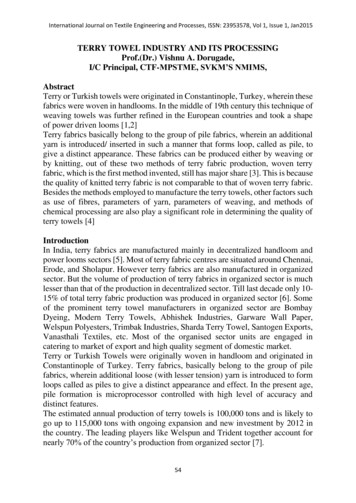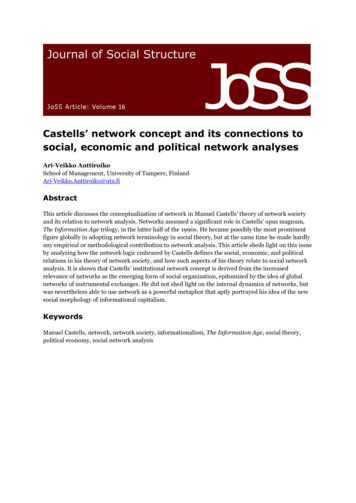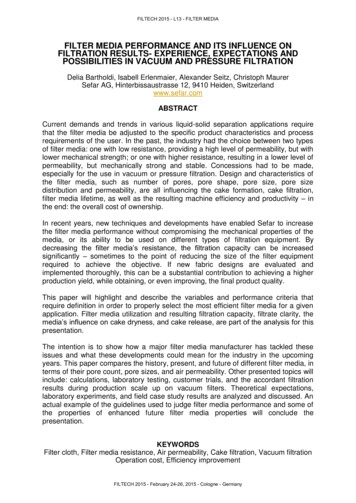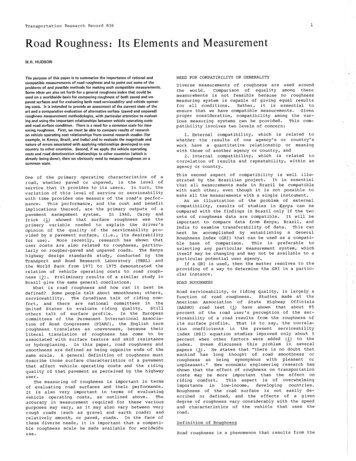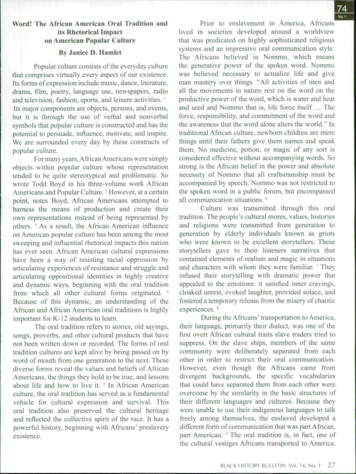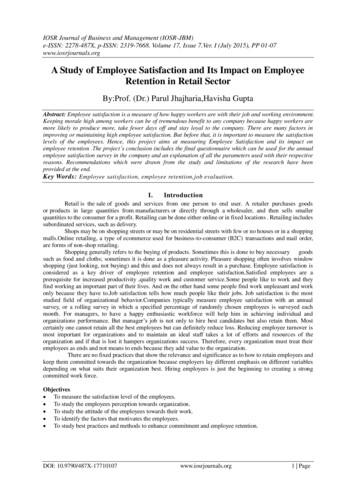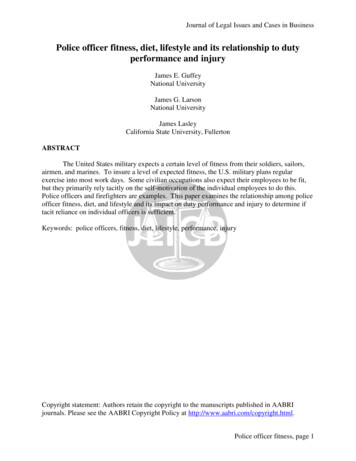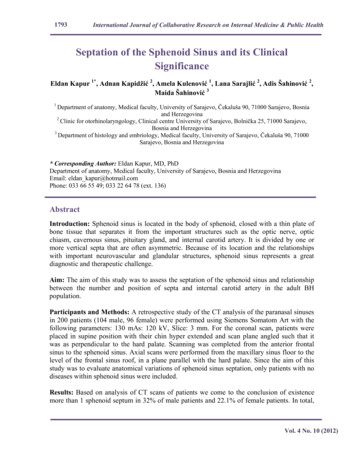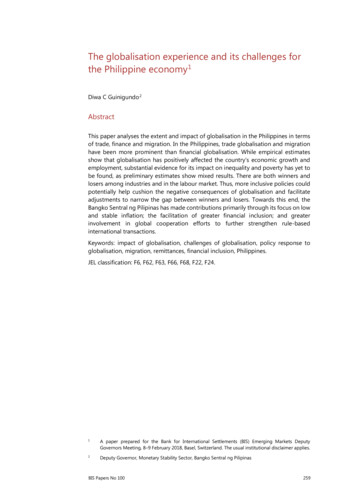
Transcription
The globalisation experience and its challenges forthe Philippine economy 1Diwa C Guinigundo 2AbstractThis paper analyses the extent and impact of globalisation in the Philippines in termsof trade, finance and migration. In the Philippines, trade globalisation and migrationhave been more prominent than financial globalisation. While empirical estimatesshow that globalisation has positively affected the country’s economic growth andemployment, substantial evidence for its impact on inequality and poverty has yet tobe found, as preliminary estimates show mixed results. There are both winners andlosers among industries and in the labour market. Thus, more inclusive policies couldpotentially help cushion the negative consequences of globalisation and facilitateadjustments to narrow the gap between winners and losers. Towards this end, theBangko Sentral ng Pilipinas has made contributions primarily through its focus on lowand stable inflation; the facilitation of greater financial inclusion; and greaterinvolvement in global cooperation efforts to further strengthen rule-basedinternational transactions.Keywords: impact of globalisation, challenges of globalisation, policy response toglobalisation, migration, remittances, financial inclusion, Philippines.JEL classification: F6, F62, F63, F66, F68, F22, F24.1A paper prepared for the Bank for International Settlements (BIS) Emerging Markets DeputyGovernors Meeting, 8–9 February 2018, Basel, Switzerland. The usual institutional disclaimer applies.2Deputy Governor, Monetary Stability Sector, Bangko Sentral ng PilipinasBIS Papers No 100259
1. IntroductionGlobalisation is defined as the mobility across borders of goods and services, people,capital and knowledge (BIS (2017a)). In the past half century, the world economy hasbecome much more integrated, interdependent and intertwined as globalisation andliberalisation appear to have become an inevitable and irreversible trend. Regionaltrading arrangements, the removal of restrictions on the flow of trade and investment,and rapid technological changes have led to the deepening of economic integrationand the heightening of globalisation (Aldaba (2011)). Emerging market economies(EMEs) have also become much more tightly integrated in terms of trade, finance,global value chains (GVCs) and migration (BIS (2017b)).Some have attributed an unprecedented period of peace and prosperity toglobalisation as it has spurred growth and productivity as well as expandingopportunities for businesses, investors and workers (Ibrahim (2017)). This is trueparticularly for EMEs, where many observers consider globalisation as a major causeof strong growth and significant poverty reduction in recent decades (BIS (2017b)).However, due to the adverse and lingering impact of the Great Financial Crisis (GFC),there has been a growing backlash against globalisation, not only in EMEs but also inadvanced economies, particularly in the United Kingdom and the United States. Apattern of resurgent protectionism is observed to be emerging across the globe andinward-looking policies are getting more support.This paper analyses how globalisation has affected the Philippines, starting withglobalisation trends in the country (Section 2), and followed by macroeconomic anddistributional consequences of globalisation (Section 3). The paper continues with adiscussion on challenges that the country faces with greater world integration(Section 4), and finally with a discussion of policies in the last section (Section 5).2. Globalisation trends in the PhilippinesThe Philippine economy, like that of most other EMEs, has become increasinglyintegrated with the global economy. This is evident in the general increase in trade ingoods and labour migration. There is also greater integration in finance, albeit at arelatively moderate pace.Trade opennessFrom the 1990s to the 2000s, trade openness in the Philippines improved from 88.1%to 101.0% of the country’s gross domestic product (GDP) (Graph 1). Contributing tothis increase were the country’s efforts towards a more open trade policy starting inthe 1980s. This trade openness also reflected declining transport costs and improvedinformation and communications technology that supported the development ofcomplex GVCs, particularly in electronics and electrical components, allowingcompanies to manage their production more efficiently (Dudley (2017)).260BIS Papers No 100
Economic globalisation indicators (% of GDP), 1990s, 2000s, 2010sGraph 1Note: Trade openness [(Exports of goods and services Imports of goods and services)/Real GDP] x 100; Financial Openness [(Inflows ofdirect investment, portfolio investment, financial derivatives and other investment Outflows of direct investment, portfolio investment,financial derivatives and other investment)/Nominal GDP] x 100. Figures from 1990 to 1999 were based on BOP Old Concept. Figures from2000 to 2004 were based on BPM5. Figures from 2005 to 2017 were based on BPM6. 2010s include January to September 2017 data forfinancial openness and January to December 2017 data for trade openness. Estimates exclude valuation changes. The analysis, however,should be taken with caution considering the break in the data series used (old, BPM5 and BPM6 concepts).Sources: National Accounts, Philippines Statistics Authority; BOP Statistics and International Investment Position, Bangko Sentral ng Pilipinas.Another factor is rapid growth in the information and communicationstechnology-business process outsourcing (ICT-BPO) services in the country. Based ondata on earnings from IT-BPO, the industry recorded above 50% annual growth from2006 to 2008, this growth remaining in double digits until 2016. The Philippines hasalso established itself as one of the two major BPO industry centres in Asia, along withIndia. With the country’s continued openness to globalisation, the total trade of thePhilippines increased further, to 101.4% of GDP in the 2010s (Graph 1). The pickup inglobal trade starting in 2017 has, in fact, helped in offsetting the weak global demandthat lingered after the GFC.Financial opennessIn terms of financial openness, globalisation came in at a more moderate pace. Thecountry’s total capital flows increased from 3.1% of GDP in the 1990s to 3.4% of GDPin the 2000s (Figure 1). While the Philippines started to liberalise the foreign exchange(FX) regulatory system in the 1990s, capital inflows were dampened by the Tequila(Mexican peso) financial crisis in 1995 and the Asian financial crisis in 1997–98(Tetangco (2005)).In the 2010s, however, total capital flows rose to 4.6% of GDP. This could beattributed in part to the nine waves of FX liberalisation reforms undertaken by theBSP starting in 2007. Another important reform undertaken to promote financialopenness was the further liberalisation of foreign bank entry in 2014.Notwithstanding this, the 4.6% average ratio of capital flows to GDP from 2010 to theBIS Papers No 100261
first three quarters of 2017 indicates that there is still scope for the country toliberalise further. 3The composition of the economy’s external liabilities has shown its increasingexposure to both portfolio and direct investments, signifying not merely foreigninvestors’ search for yield but growing confidence in the country’s macroeconomicfundamentals (Graph 2). From end-December 1999 to end-September 2017, the stockof foreign direct investments (FDI) increased by 816.9%. 4 As a share of GDP, FDI hasincreased from 9.6% at end-1999 to 23.5% at end-September 2017. Relative to GDP,FPI has increased from 18.7% at end-December 1999 to 25.8% at end-September2017.Moreover, external assets show a sustained increase in foreign exchange reservesfrom 18.2% of GDP at end-December 1999 to 26.2% of GDP at end-September 2017(Graph 3), reflecting large and stable structural flows coming from overseas Filipinoremittances and IT-BPO receipts. Notable also is the substantial increase in residents’direct investments abroad, from only 0.8% of GDP at end-December 1999 to 14.9%of GDP at end-September 2017. Residents’ portfolio investments in other countrieslikewise increased from 1.5% of GDP in end-December 1999 to 5.2% at endSeptember 2017, signifying the rising internationalisation of domestic corporates andinvestors.External liabilities, 1999–Q3 2017(% of GDP, end-period)Graph 2External assets, 1999–Q3 2017Graph 3(% of GDP, end-period)Note: External assets and liabilities data are based on International Investment Position (stock data). For end-1999 and end-2000, the data wereestimated using Balance of Payments (BOP) statistics figures for 2000 and 2001, respectively. Figures from end-2001 to end-2005 were basedon BPM5. Figures from end-2006 to end-September 2017 were based on BPM6. Estimates exclude valuation changes. The analysis, however,should be taken with caution considering the break in the data series used (relating to the BPM5 and BPM6 concepts).Sources: National Accounts, Philippines Statistics Authority; BOP Statistics and International Investment Position, Bangko Sentral ng Pilipinas.3Based on IMF (2017), while the Philippines made a significant progress in liberalising capital flows inthe past 10 years, foreign exchange market development and interbank market in the country arestill below potential.4The cited figure is the computed growth rate of the stock of FDI in end-September 2017 from endDecember 1999. The data are based on International Investment Position, a stock statistic.262BIS Papers No 100
MigrationInternational migration from the Philippines increased further as data from the UnitedNations indicate that the ratio of Filipino migrants to the country’s total populationwent up from 3.5% in 1995 to 5.4% in 2017, 5 and the ratio of the stock of overseasFilipinos to the country’s total population increased from 9.4% in 1997 to 10.4% in2013. 6The Philippines has been open to labour mobility since the 1970s, and this hasprovided the country with decades of experience as a source of internationalmigrants. The primary reason for Filipinos’ continued emigration has been to seekemployment overseas. While the Philippine economy has been steadily improving inrecent years, with unemployment rate declining from 7.5% in 2009 to 5.0% in 2017,the country’s unemployment situation 7 is still commonly cited as one of the mainreasons why Filipinos continue to search for work abroad. 8 Employment opportunitiesin other countries, regardless of the type of job, are perceived to offer highersalaries/compensation, and better income and lifestyle packages (eg health benefits,insurance).Another set of factors that promoted greater labour mobility pertains to globalevents that enhanced the international migration opportunities of Filipinos,particularly in extending their workplace to a global scale. For instance, the adoptionof more liberal immigration policies in the 1970s; the oil crisis of 1973 that facilitatedthe emergence of the Gulf region as a destination for temporary migrant workers; therise of the new industrialised countries in East and Southeast Asia that spurredadditional demand for migrant labour in the 1980s; and globalisation have all led toglobal demand for skilled and professional workers.Lastly, labour migration has been explained by so-called contagious migration.This refers to the widespread interest in migration that has resulted from the influenceof the growing number of migrants. This seems to have become a social constructthat is now ingrained in Philippine culture. For instance, migration seems to betransmitted within families from one generation to the next. 95Figures were estimated using United Nations (UN) data on the stock of migrants from the Philippinesand estimates of the Philippine Statistics Authority on latest population of the Philippines. The UNdefines the stock of migrants as the number of people born in a country other than that in whichthey live (Source: United Nations, Department of Economic and Social Affairs, Population Division(2017)).6Figures were estimated using data from the Commission on Filipinos Overseas on stock of overseasFilipinos (latest data are 2013) and the estimates of the Philippine Statistics Authority on the currentpopulation of the Philippines.7According to the Department of Labor and Employment (DOLE), the unemployment problem in thecountry is not just about the lack of jobs, but also includes the mismatch between the human capitalportfolio of job applicants and the requirements of the labour market. The business processoutsourcing (BPO) sector, for instance, is having difficulties in finding qualified workers.8Pinoy OFW Portal, “Eight Reasons why many Filipinos want to work abroad”, os-like-to-work-abroad.html.9The motivation to improve the family’s welfare and status led either parents or their children tomigrate abroad – for parents, it is to provide a better future for their children, whereas for the children,migration is seen as a means of providing a comfortable life for their parents. There is a disseminationand sharing of information that encourages migration. The tendency for migration to spread fromBIS Papers No 100263
Based on the latest estimate from the Commission on Filipinos Overseas,overseas Filipinos (OFs) are now scattered more geographically, from the traditionaldestinations, comprising mostly the advanced economies, to EMEs, which have beenincreasingly tapping OF services and skills. 10 The profile of Filipino migrants has alsochanged from mostly middle and lower skilled workers (1970s) to professionalworkers (1990s) as well as services (2000s and 2010s) and production workers (2010s)(Ang et al (2009)).As a result, the remittances sent by OFs have substantially increased, from 2.5%of GDP in 1990 to 9.2% of GDP in the first three quarters of 2017. The Philippines wasthe third highest recipient country for remittances in 2017 and has been in the top 10since 1994 (W
global trade starting in 2017 has, in fact, helped in offsetting the weak global demand that lingered after the GFC. Financial openness In terms of financial openness, globalisation came in at a more moderate pace. The country’s total capital flows increased from 3.1 % of GDP in the 1990s to 3.4% of GDP in the 2000s (Figure 1). While the Philippines started to liberalis e the foreign .


